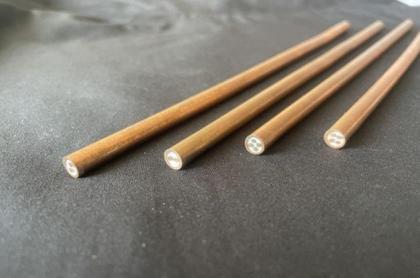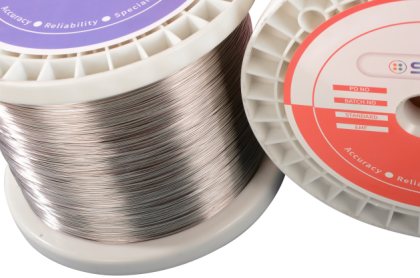El termopar es un elemento de detección de temperatura y un instrumento primario. Mide directamente la temperatura y convierte la señal de temperatura en una señal de fuerza electromotriz térmica, que se convierte en la temperatura del medio medido a través de un instrumento eléctrico (instrumento secundario). El principio básico de la medición de la temperatura del termopar es que dos conductores de diferentes composiciones forman un circuito cerrado. Cuando hay un gradiente de temperatura en ambos extremos, una corriente pasará a través del bucle. En este momento, habrá una fuerza electromotriz, una fuerza electromotriz térmica, entre los dos extremos. Este es el teseebeckefect. Dos conductores homogéneos con diferentes composiciones son electrodos calientes, el extremo con una temperatura más alta es el extremo de trabajo y el final con temperatura más baja es el extremo libre. El extremo libre suele ser a una temperatura constante. Se realiza una tabla de índice de termopar se basa en la relación funcional entre la fuerza y la temperatura termoelectromotriz; La tabla de índice se obtiene cuando la temperatura final libre es de 0 ° C. Diferentes termopar tiene diferentes graduaciones. El principio básico de la medición de la temperatura del termopar: dos conductores o semiconductores A y B de diferentes materiales se soldan para formar un circuito cerrado. Cuando hay una diferencia de temperatura entre los dos puntos de unión 1 y 2 de los conductores A y B, se genera una fuerza electromotriz entre los dos, formando así una corriente grande en el bucle. Este fenómeno se llama efecto termoeléctrico. El método de usar termopar, como la selección de puntos de prueba, profundidad de inserción, tiempo de respuesta, etc., causará errores de medición.
1. Factores
1.1. Efecto de la inserción.
1.1.1. Selección de puntos de tiempo de transmisión
La ubicación de instalación del termopar y la selección del punto de medición de temperatura son los más importantes. La ubicación del punto de medición de temperatura debe ser típica y representativa para el proceso de producción, de lo contrario se perderá el significado de medición y control.
1.1.2. Inserción Deph
Cuando se inserta un termopar en el campo de temperatura que se mide, se producirá un flujo de calor a lo largo del sensor. La pérdida de calor ocurre cuando la temperatura ambiente es baja. Como resultado, la temperatura del termopar y el objeto que se mide es inconsistente, lo que resulta en errores de medición de temperatura. En resumen, el error causado por la conducción térmica está relacionado con la profundidad de inserción. La profundidad de inserción está relacionada con el material del tubo protector. Debido a su buena conductividad térmica, el tubo de protección de metal debe insertarse más profundo (aproximadamente 15 veces el diámetro). Los materiales cerámicos tienen buenas propiedades de aislamiento térmico y se pueden insertar menos profundos.
1.2. Impacto en el tiempo
El principio básico del método de contacto de la medición de la temperatura es que el elemento de medición de temperatura debe alcanzar el equilibrio térmico con el objeto que se mide. Por lo tanto, se requiere una cierta cantidad de tiempo para lograr el equilibrio térmico entre los dos al medir la temperatura. La longitud del tiempo de retención está relacionada con el tiempo de respuesta térmica del elemento de medición de temperatura. El tiempo de respuesta térmica depende principalmente de la estructura del sensor y las condiciones de medición. Para los medios de gas, especialmente el gas estacionario, debe mantenerse durante al menos 30 minutos para alcanzar el equilibrio. La marca de navegación estipula que el tiempo de preservación de calor de cada punto de detección debe ser de 30 minutos; Para los líquidos, el más rápido debe ser más de 10 minutos.
Para el lugar medido donde la temperatura cambia constantemente, especialmente el proceso de cambio instantáneo, todo el proceso solo toma 1 segundo, se requiere que el tiempo de respuesta del sensor esté en el nivel de milisegundos. Por lo tanto, los sensores de temperatura ordinarios no solo se retrasan detrás de la tasa de cambio de temperatura del objeto que se mide, sino que también produce errores de medición debido a la falla para lograr el equilibrio térmico. Es mejor elegir un sensor con respuesta rápida. Para el termopar, además de verse afectado por el tubo protector, el diámetro del extremo de medición del termopar también es un factor importante. Cuanto más delgado sea el cable, más pequeño es el diámetro del extremo de medición, y más corto es el tiempo de influencia térmica.
1.3. Efecto de la radiación térmica
El termopar insertado en el horno para la medición de la temperatura se calentará por la radiación térmica emitida por el objeto de alta temperatura. Se supone que el gas del horno es transparente. Además, cuando la diferencia de temperatura entre el termopar y la pared del horno es grande, los errores de medición de temperatura se producirán debido al intercambio de energía. Para reducir los errores de radiación térmica, se debe aumentar la conducción de calor y la temperatura de la pared del horno debe estar lo más cerca posible de la temperatura del termopar. Además, se debe prestar atención a lo siguiente durante la instalación:
<33
(1) La posición de instalación del termopar debe estar lo más lejos posible de la radiación de calor emitida por el cuerpo sólido para que no pueda irradiar hasta la superficie del termopar.
(2) Está preferiblemente equipado con una manga de blindaje de radiación de calor.
1.4. Efecto del aumento de la impedancia térmica
Si el medio medido está en un estado gaseoso, el polvo depositado en la superficie del tubo protector se derretirá en la superficie, lo que provocará que la resistencia térmica del tubo protectora aumente; Si el medio medido es una fusión, habrá depósitos de escoria en el termopar durante el uso, lo que no solo aumenta el tiempo de respuesta del termopar, sino que también hace que la temperatura indicada sea más baja. Por lo tanto, además de las inspecciones regulares, también son necesarias inspecciones frecuentes de puntos para reducir los errores.
2. Atención
2.1. Afectores de homogeneuse de alambre
2.1.1. El termoacoplatero es nootomogéneo
De acuerdo con los requisitos de las regulaciones, cuando el termopar es calibrado por el departamento de medición, la profundidad de la inserción en el horno de calibración es de solo 300 m. El resultado de la calibración de cada termopar puede reflejar o reflejar principalmente el comportamiento termoeléctrico del alambre de 300 mm de largo comenzando desde el extremo de medición. Sin embargo, cuando la longitud del termopar es larga, la mayor parte del cable está en la zona de alta temperatura. Según la ley del bucle homogéneo, si el cable de termopar es homogéneo, el resultado de la medición no tiene nada que ver con la longitud. Sin embargo, cualquier cable no es homogéneo, especialmente metalona barata, que tiene homogeneidad y se encuentra en situaciones con gradientes de temperatura. El gradiente de temperatura a menudo es irregular y no necesariamente mantiene un valor constante en todo el bucle y dirección. Al mismo tiempo, el tamaño y la posición cambian constantemente, y el cable uniforme debe permanecer uniforme durante toda su longitud para que se pueda confiar en la señal potencial obtenida.
2.1.2. Homogeneidad
Para el termopar recién hecho, incluso la fuerza electromotriz térmica no uniforme puede cumplir con los requisitos. Sin embargo, el envejecimiento y la contaminación pueden cambiar la uniformidad del termopar. El procesamiento y la flexión repetidos causarán la distorsión de procesamiento del termopar, lo que también hará que pierda su homogeneidad. Además, cuando el termopar está expuesto a alta temperatura durante mucho tiempo durante el uso, la fuerza electromotriz térmica cambiará debido al deterioro del cable de termopar. Cuando la parte deteriorada del termopar está en un lugar con un gradiente de temperatura, la fuerza electromotriz parasitaria se generará y se superpondrá en la fuerza electromotriz térmica total, lo que resulta en errores de medición. El termopar blindado tiene una buena ventaja a este respecto, y la uniformidad del cable no es fácil de cambiar durante la operación.
3. Deterioro y vida útil del termopar
3.1. Deterioro de la termopar
La vida útil de un termopar está relacionada con su deterioro. El deterioro de un termopar significa que el envejecimiento y el deterioro después del uso. El termopar hecho de metal o aleaciones tiene granos internos que crecen gradualmente a altas temperaturas. Al mismo tiempo, la aleación contiene una pequeña cantidad de impurezas, y su posición o forma también cambiará. Además, también reacciona a la reducción o oxidación de gases en el entorno circundante. Junto con los cambios anteriores, la fuerza termoelectromotora del termopar también será extremadamente sensible a los cambios. El deterioro del termopar es inevitable.
3.2. Vida útil
El deterioro del termopar es un proceso cuantitativo, y es difícil cuantificarlo. Variará con el tipo de termopar, diámetro, temperatura de funcionamiento, atmósfera y tiempo. La vida útil se refiere al deterioro del termopar que excede el error permitido.
3.2.1. La vida de la termocople de base
En uso real, el termopar ensamblado generalmente tiene tubos protectores. La seda desnuda se usa solo en circunstancias especiales. Por lo tanto, en la mayoría de los casos, la vida del tubo de protección determina la vida útil del termopar. El juicio de la vida útil real del termopar debe basarse en la recopilación y acumulación de datos a largo plazo en condiciones de uso real para poder dar resultados más precisos.
3.2.2. Life ArmoredThermocouple
Dado que el termopar blindado está protegido por una carcasa y está aislado del entorno externo, el material de la carcasa tiene una gran influencia en la vida. El cable de termopar y la carcasa de metal deben seleccionarse de acuerdo con el propósito. Cuando se selecciona el material, su vida útil aumenta a medida que aumenta el diámetro del termopar blindado. Aunque tiene muchas ventajas sobre el termopar ensamblado, lo cual es propenso al deterioro.






 Network IPv6 compatible con
Network IPv6 compatible con